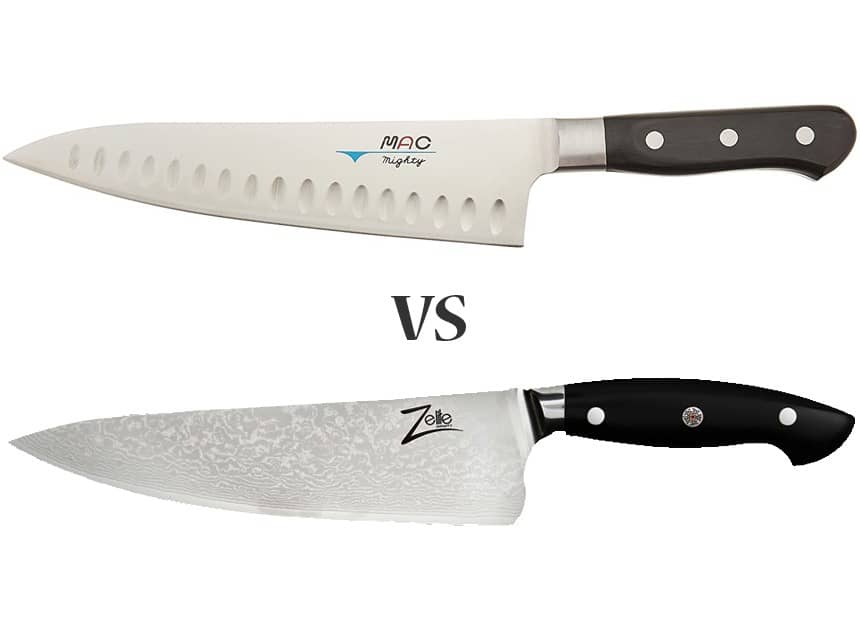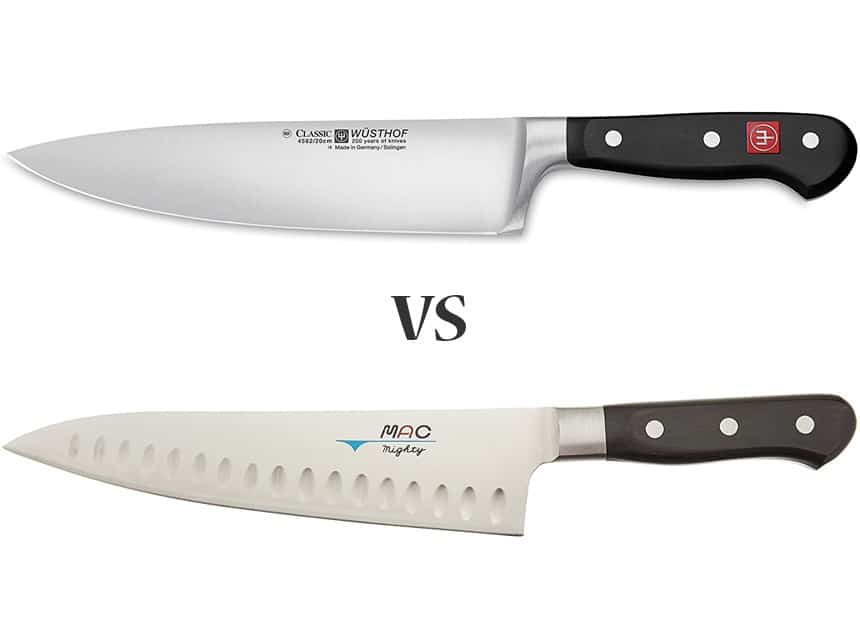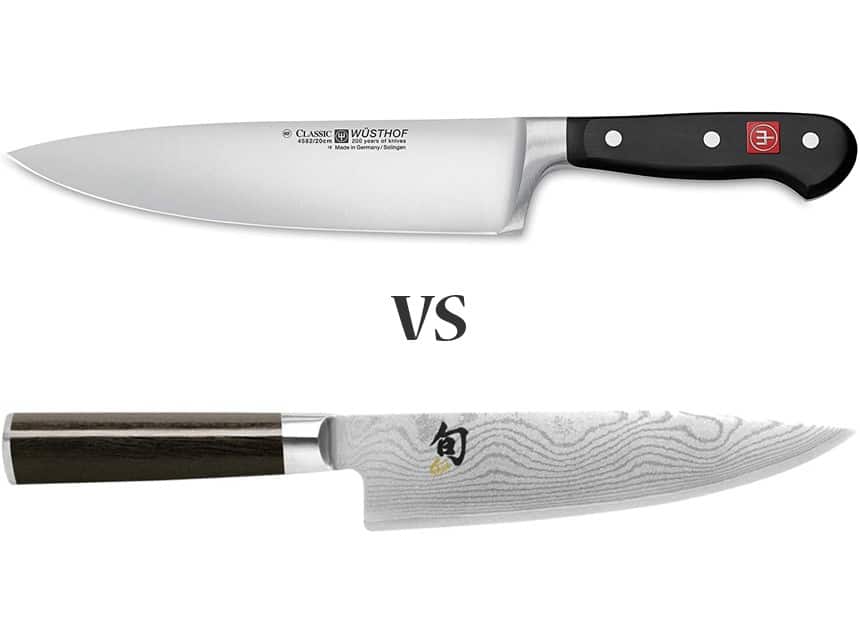
There have been a lot of Chinese brands entering the knife market in recent years.
Quite frankly, some of these brands aren’t great. They can be low quality and the marketing can be misleading at best.
However; there are some Chinese manufactured brands that are offering good quality knives, and one of those is Zelite.
Increasingly consumers are trying to understand the differences between brands like Zelite and actual Japanese brands like Mac.
In this article, I’m going to tell you the differences between these two brands. I’ll go in-depth into the details of each, talking about where they are made, what materials are used and the difference in price.
This should be all the information you need to select your perfect knife.
If you’re looking for an authentically Japanese, super sharp knife then the Mac is the one for you. If you don’t care so much about heritage and want to get the most for your money in terms of purely quality materials then the Zelite is a great choice. Either way, both these brands offer terrific knives.
| My recommendation | Current price |
| Mac Professional 8-Inch | View on Amazon (opens new tab) |
| Zelite Executive Plus 8-Inch Chef’s Knife | View on Amazon (opens new tab) |
Mac vs Zelite – Comparison Table
Here is my summary comparison table for each brand. This is mostly based on their main range of knives; the Mac Professional and the Zelite Executive Plus.
For a more in-depth look at each category then check out the rest of the article below.
| Category | Mac | Zelite |
| Country of Manufacture | Japan | China |
| Steel type | VG-5 | AUS-10 (other ranges use VG10 and X50CrMoV15) |
| Rockwell hardness | HRC 59-61 | HRC 61 |
| Factory edge | ~15 degrees (double bevel) | 12 degrees (double bevel) |
| Handle material | Pakkawood (wood/resin composite) | G10 (fiberglass laminate) |
| Price range | $160 – $180 (Professional) | $130 – $140 (Executive Plus) |
| Main benefit | Sharp and authentically Japanese | Lower price, sharp and comfortable |
| My recommendation | 8-Inch Professional (view on Amazon) | Zelite Executive Plus (view on Amazon) |
Mac vs Zelite – Where are they made
| Brand | Country of manufacture |
| Mac | Japan |
| Zelite | China |
All Mac knives are manufactured in the Japanese city of Seki. Seki is known as the knife capital of Japan, with a population of only 90,000 it lies around 150 miles from Toyoko but is the central hub for all of Japan’s major knife manufacturers.
Mac has been making knives since 1964, selling over 25 million of their fantastically designed East-meets-West knives.
Zelite manufactures it’s knives in Yangjiang, China.
Zelite is a relatively small, family-owned business. On the face of it, the fact that Zelite knives are manufactured in China might be a little off-putting.
Let’s be honest, when we see the words ‘Made in China’ we usually think that the quality isn’t going to be great, but with Zelite I think there are some large benefits from having production based there.
They still use quality materials, but as the manufacturing costs are kept low these savings are passed onto the customer.
Zelite provides a range of both Japanese and German-influenced knives, in this article though I’m mainly focusing on their most popular Japanese style Executive Pro.
Mac is the ‘real-deal’ in regard to being produced directly in the heartland of its Japanese heritage, whilst Zelite is definitely less authentic.
Mac vs Zelite – What steel do they use
The steel used in knives will often change depending on which range you pick.
This is particularly true of Zelite. They use a number of different steels throughout their ranges as they have both German and Japanese influenced knives.
Their German series uses X50CrMoV15 and their Japanese series use both AUS-10 and VG-10 depending on the range.
For a fair comparison, I’m going to focus on the most popular range for both Mac and Zelite knives.
For Mac that’s their ‘Professional’ range, sometimes referred to as their ‘Mighty’ range and for Zelite it’s their Executive Plus range.
| Brand | Steel type | Rockwell hardness |
| Mac Professional | VG-5 | HRC 59-61 |
| Zelite Executive Pro | AUS-10 | HRC 61 |
The Mac Professional range uses the Japanese steel VG-5. All Mac knives are made from some version of the Takefu V-Gold (VG) steel varieties.
It’s a hard steel and we can see why when we look at VG-5’s levels of Carbon, Vanadium and Chromium.
The Carbon level is much around 0.75%. Higher Carbon levels make the steel harder, allowing for a finer edge, but it also makes it more brittle and prone to chipping.
The Chromium content is around 14%, that’s no super higher but still makes this a quality stainless steel that will be very resistant to rust.
The Zelite Executive Plus range uses Japanese steel AUS-10. Other Zelite knives use X50CrMoV15 (for their German range) and VG-10 (another Japanese steel).
This is where we start to see the benefits of Zelite knives, the materials they use are very good quality, in this case, imported from Japan, but the Chinese manufacturing reduces the cost to the consumer.
AUS-10 is a Japanese steel with a great reputation. It’s a high carbon steel, with a Carbon content between 0.95% – 1.1%.
That means the steel is very hard, allowing it to hold a sharper edge for longer.
The Chromium level is also high at 13% – 14.5%. Again, that’s not as high as many quality western-style knives (often 15% Chromium), but it’s still enough to make AUS-10V a quality stainless steel and therefore very rust-resistant.
That hardness is clearly shown in the Rockwell scale score. Both these brands have a high score topping out at HRC 61.
Mac vs Zelite – How sharp are they
Once again I’m going to focus on the most popular knives from each brand for this comparison.
You will experience a slightly sharper edge with the Mac. The Mac’s Japanese influenced off-center angle increases the sharpness. Ultimately though the difference is quite minimal and both these knives will give you a super sharp edge with great edge retention.
| Brand | Factory edge | Rockwell hardness |
| Mac Professional | ~15 degrees (off-center double bevel) | HRC 59-61 |
| Zelite Executive Pro | 12 degrees (double bevel) | HRC 61 |
Sharpness is vital when looking for a knife, but in this case, there’s a bit more to it than just looking at which knife has the smallest angle of its edge.
Usually, the smaller the angle the sharper the blade. However, there are other considerations that are particularly important when comparing these two knives.
Harder knives will hold a sharper edge for longer. Both these knives use steel of similar hardness.
The main difference cis in the way Mac designs the edge of their knife.
Whereas most knives use a standard bevel edge, with each side of the knife slanting at the same angle to form a point, Mac knives have an off-center angle to the edge.
That means that one side of the knife has a smaller angle than the other, a technique that results in a sharper blade.
It’s a mix between the Japanese style of a single bevel edge, which are incredibly sharp, and a western double bevel edge.
The combination of this edge design and the hard steel means that you will experience a very sharp edge using Mac knives, even though the steel is technically quite similar to the Zelite.
Overall, you’re going to experience a similar, extremely sharp edge with both of these knives, but the Mac will just be slightly sharper.
Mac vs Zelite – What are the handles made from
The material used for handles is a vital and often overlooked feature of any knife.
A quality handle is often the sign of a quality overall knife. Handles need to be made from a durable material that can withstand all the heat and moisture fluctuations knives can experience in the kitchen.
Once again we’ll focus on the two main ranges from each brand, the Mac Professional and Zelite Executive Pro knives.
| Brand | Handle material |
| Mac Professional | Pakkawood (wood/resin composite) |
| Zelite Executive Pro | G10 (fiberglass laminate) |
Mac use a wood/resin composite called Pakkawood for their knife handles.
Pakkawood is extremely common in knife handles for quality Japanese knives, although many non-Japanese knife manufacturers around the world have begun to use it as well.
Pakkawood is a great material for knife handles, it’s more dense and durable than real timber. That means it’s more resistant to wear and tear and won’t crack over time as timber handles might.
The versatility of design also makes it a popular choice, it can be dyed all sorts of colors and will often give the appearance of a true wood finish.
Pakkawood is very resilient to temperature and moisture changes and makes a terrific material of choice, it also adds to the Japanese influence of the knife with Pakkawood being a popular Japanese knife handle material.
Zelite uses a fiberglass laminate called G10 for their Executive Plus knife handles. Not all Zelite knives use G10 but all Zelite ranges do use good quality materials for their handles such as Pakkawood.
G10 is a fiberglass laminate, making it a fantastic material for knife handles.
It has the perfect combination of being extremely lightweight and very tough. It will be able to withstand any of the standard pressure of a kitchen.
Zelite focuses quite heavily on making comfortable handles and their knife ranges do use a variety of materials for their handles, not just G10.
But they always use quality materials, such as Pakkawood for their Alpha-Royal Japanese Series, a quality wood/resin material commonly used as a material by traditional Japanese knife manufacturers.
So whichever range of Zelite knives you choose, you can be confident that the handle will be a quality, durable and comfortable one.
Both Pakkawood and G10 are top-quality knife handle materials so there is little to choose between the two here.
Mac vs Zelite – How much do they cost
Both these brands have wide ranges of knives all at differing price ranges.
To allow for a fairer comparison I’ve categorized three of their major ranges that represent their highest and lowest cost knives.
I’ve tried to compare similar knives, sticking to 8 Inch Chef’s knives or the closest equivalent they have in the range. E.g. The Mac Ultimate is actually a 9-inch knife.
In brackets next to the general price range you’ll see the name of the range.
These prices are rough estimates. Prices do change over time but this is intended as a rough guide.
| Brand range | Mac | Zelite |
| Premium | > $200 (Ultimate) | $140 – $150 (Executive-Plus Series Master) |
| Standard | $160 – $180 (Professional) | $130 – $140 (Executive-Plus Series) |
| Value | $80 – $100 (Chef’s Series) | $50 – $60 (Alpha-Royal German Series) |
What is clear is that Zelite continually offers their knives at a slightly lower price point, and this is typical of the new, high-quality Chinese knives entering the market.
They are using materials of similar quality but reducing their manufacturing cost significantly by basing production in China. As a result, they can continually undercut the prices of the knife manufacturers based in places like Japan.
Mac vs Zelite – What is the difference
Now that we have looked at the design, materials, background and price of these brands we can fully understand the difference, and you should be able to make an informed decision on which knife is correct for you.
The main difference between Mac and Zelite knives is that Mac knives offer a brilliant product that is authentically Japanese, whilst Zelite offer a great knife, using equally quality materials for a lower price, but they are not authentically Japanese. For many people, when paying upwards of $150 for a knife, that authenticity is important.
| Brand | Main benefit |
| Mac | Sharp and authentically Japanese |
| Zelite | Low price, sharp and comfortable |
Zelite makes great knives for the price, that’s a fact that I think even the most die-hard Japanese knife enthusiasts would accept.
However; at the end of the day, they are not a Japanese knife manufacturer. When people are looking to pay hundreds of dollars for just one or two knives then that authenticity often matters more than the slight price difference.
In terms of quality, there is not a great deal of difference between these two knives.
Mac vs Zelite – Which is better for you
This really comes down to what is important to you..
For anyone interested in a truly Japanese knife I would recommend the Mac all day long. But if you’re not bothered about the heritage and are looking for a quality knife that represents very good value for money, the Zelite is a great choice.
I know that a lot of people will expect the ‘real deal’ if they are paying $150 plus for a single knife. If it says it’s Japanese they expect it to be made in Japan.
If that’s you then the $30 – $50 price difference between Mac and Zelite won’t matter all that much, that difference might be worth paying in order to get a truly Japanese knife.
But if that heritage side isn’t that important to you and you just want a quality knife, using quality materials but at great value, you won’t be disappointed with a Zelite.
My Mac Recommendation

View the 8-Inch Professional Mac on Amazon (opens new tab)
For my Mac recommendation, I’m also going to the mid-range priced Professional Chef’s knife.
With this Japanese knife, you get a hard steel and unique blade design, allowing for a sharper edge.
The side of the knife is also dimpled, which reduces the surface area and thus stops food from sticking to the blade, another clever design touch.
The materials used are all premium quality and, although the Mac’s steel might not be as durable as the Mercer’s steel, for a Japanese knife with a large Carbon content it is actually very durable and at 14% Chromium is a good quality stainless steel too.
Some high-Carbon Japanese knives contain almost no Chromium at all and can begin to rust overnight if left wet, this Mac is a far cry from those.
It may not be as durable as the super-durable western-style knives, but when it comes to Japanese blades this Mac is a great balance between amazing sharpness and durability.
My Zelite Recommendation

View the 8-Inch Zelite Executive Plus on Amazon (opens new tab)
If you’re after the razor-sharp edge offered by Japanese steel, but don’t want to pay the cost of a Japanese manufactured knife, then the Zelite Executive Plus is a great choice.
As a comparison, the Miyabi Kaizen II 8-inch Chef’s Knife, which is a quality, Japanese knife made in Japan, uses steel of the same hardness but costs around 50% more than the Zelite Executive Plus.
The Executive Plus series in particular also has a very ergonomically designed handle, using G10 to make it very lightweight and curved to perfectly fit into the palm of your hand.
It’s a great knife, for a great price. If you’re on a budget but still looking for quality, you can go far wrong with this.
In fact, you could get the Zelite Executive Plus and a Zelite Comfort-Plus Series and still pay less than you would for one Japanese made knife.
That way you have the best of both worlds, one super sharp Japanese steel knife and one durable German steel knife.

